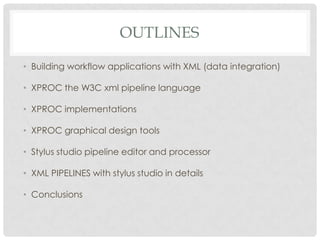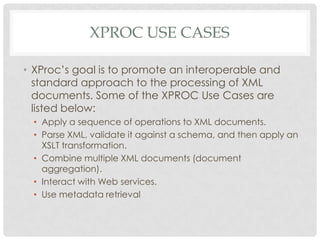XML Pipelines
- 1. XML PIPELINES USING STYLUS STUDIO
- 2. OUTLINES âĒ Building workflow applications with XML (data integration) âĒ XPROC the W3C xml pipeline language âĒ XPROC implementations âĒ XPROC graphical design tools âĒ Stylus studio pipeline editor and processor âĒ XML PIPELINES with stylus studio in details âĒ Conclusions
- 3. BUILDING WORKFLOW APPLICATIONS WITH XML (BY DR. MICHAEL KAY) âĒ âXML fits very well with workflow applications, because it's natural to think of them in terms of documents. In fact, I think it's such a good fit that I think one should often design an application as an XML-based workflow where we might have adopted a completely different approach in the past.â âĒ âGenerally when we do the initial modeling for an application we split it into two parts: the data model and the process model. Sometimes we focus more on one, sometimes more on the other. One of the difficulties is often in seeing how the two models relate to each other.â âĒ âthe XML approach to information management is a half-way house between the rigid discipline of the traditional database approach, and the uncontrolled chaos of the email-and-spreadsheet culture. But that doesn't mean it's a messy compromise: on the contrary, I would argue that it gives you the best of both worldsâ
- 4. WHAT IS XPROC? âĒ XProc is an XML Pipeline Language âĒ XProc enables you to declaratively express the activities you want to perform on XML documents âĒ XProc is a W3C recommendation (2010) âĒ http://www.w3.org/TR/xproc/
- 5. BENEFITS OF XPROC? âĒ XProc takes care of orchestrating all the activities âĒ XProc is a standard way of expressing processing activities âĒ Since an XProc document is an XML document, you can send it around, transform it, mine it, store it, just like any other XML document
- 6. XPROC USE CASES âĒ XProcâs goal is to promote an interoperable and standard approach to the processing of XML documents. Some of the XPROC Use Cases are listed below: âĒ Apply a sequence of operations to XML documents. âĒ Parse XML, validate it against a schema, and then apply an XSLT transformation. âĒ Combine multiple XML documents (document aggregation). âĒ Interact with Web services. âĒ Use metadata retrieval
- 7. XPROC PIPELINE EXAMPLE âĒ The following pipeline validates the input against a schema depending on a version attribute, then applies an XSLT.
- 9. THE NEED FOR XPROC âĒ XProcâs declarative format, combined with the simplicity of thinking in terms of pipelines, will mean that non-technical people can be involved in writing and maintaining processing workflows. âĒ XProc, in many configurations, is amenable to streaming, whereas other approaches to control XML processes are not (for example, XSLT). âĒ XProc steps focus on performing specific operations, which over time should experience greater optimization (in an XProc processor used by many) versus one-off code that you or I write (used by few). âĒ XProc's standard step library and extensibility mechanisms position XProc to be an all-encompassing solution. âĒ Structured data (such as XProc markup) is typically easier to reuse than structured code. âĒ One of XProc's inspirations is UNIXÂŪ pipelines, which hopefully all can agree is a good thing!
- 10. XPROC IMPLEMENTATIONS âĒ Calabash maintained by Norman Walsh âĒ Calumet, EMCâs XProc implementation âĒ QuiXProc, Innovimax's (GPL) version in Java implementing Streaming and Parallel processing âĒ Tubular (LGPL) maintained by Herve Quiroz âĒ xprocxq, XQuery implementation on top of eXist
- 11. XPROC GRAPHICAL TOOLS âĒ The EMC XProc Designer is graphical tool for designing XML Processing pipelines according to the W3C standard Xproc. âĒ The stylus studio Pipeline editor
- 12. EMC XPROC DESIGNER âĒ Is a graphical tool for designing XML Processing pipelines according to the W3C standard Xproc. âĒ Intuitive design of XProc pipelines using Drag and Drop âĒ On-the-fly validation of pipelines âĒ Pipeline execution using the embedded EMC Documentum XProc Engine âĒ Compliant to the W3C XProc specification âĒ On-line Help
- 13. EMC XPROC DESIGNER : KNOWN ISSUES âĒ The EMC XProc Designer is currently an early access release and there are known issues and missing features, including: âĒ Currently unsupported XProc constructs: âĒ p:import âĒ âĒ âĒ âĒ Only basic support for authoring inline content Limited support for namespaces Not all static XProc errors are checked for Currently the XProc Designer is available as a browser application only.
- 14. EMC XPROC DESIGNER : ROADMAP âĒ The EMC XProc Designer is currently an early access release and there are known issues and missing features. âĒ âĒ âĒ âĒ âĒ âĒ âĒ Importing pipeline libraries Better support for opening 3rd party pipelines Support for local step declarations and recursive pipelines Better support for authoring XPath expressions Visual debugger Round trip text editing - visual design Usability improvements
- 15. THE STYLUS STUDIO XML PIPELINE TOOL âĒ is a powerful XML application design tool that lets software architects design XML data services at a higher and more integrated level, rather than manually editing individual stylesheets, queries, schemas, Web services. âĒ allows developers to quickly and easily model their entire application as a sequence of XML processing operations: âĒ A typical XML application might involve converting legacy data into an XML format, validating the resulting XML document, then transforming it to HTML.
- 16. STYLUS STUDIO XML PIPELINE EDITOR IN DETAILS âĒ Helps create and generate code for xml pipelines âĒ Pipeline=Applications that perform a series of linked xml processing operations: âĒ XQuery , XSLT, and xml conversion and validation âĒ Nodes represent xml operations, and application processing, âĒ Lines between nodes, represent flow of data from on node to another. They are called pipes.
- 17. STYLUS STUDIO XML PIPELINE EDITOR
- 18. STYLUS STUDIO XML PIPELINE EDITOR âĒ An xml pipeline example that converts a text file and an EDI file to xml, and uses xslt and xquery, to create html and pdf reports.
- 19. INPUT FILES booksXML.txt âĒ âĒ âĒ âĒ âĒ âĒ âĒ "isbn"|"title"|"manufacturer"|"releaseDate" "0070498873"|"Implementing CDF Channels"|"McGrawHill Osborne Media"|"06 March, 1998" "007134621X"|"Inside XML DTDs: Scientific and Technical"|"McGraw-Hill Companies"|"25 June, 1999" "0071371885"|"XML: eCommerce Solutions for Business and IT Managers"|"McGraw-Hill Trade"|"12 March, 2001" "0071418733"|"XML for Wireless Communications"|"McGraw-Hill Professional Publishing"|"30 September, 2003" "0071418741"|"XML for Wireless Communication with CDROM (McGraw Hill Developers)"|"McGraw-Hill Companies"|"August, 2003" "007141956X"|"Teach Yourself HTML Publishing on the World Wide Web"|"McGraw-Hill"|"14 January, 2003" order.edi âĒ âĒ âĒ âĒ âĒ âĒ âĒ âĒ âĒ âĒ âĒ âĒ âĒ âĒ âĒ âĒ âĒ âĒ âĒ âĒ âĒ âĒ âĒ UNA:+.? ' UNB+UNOC:4+STYLUSSTUDIO:1+DATADIRECT:1+20051107:1159+6002' UNH+SSDD1+ORDERS:D:03B:UN:EAN008' BGM+220+BKOD99+9' DTM+137:20051107:102' NAD+BY+5412345000176::9' NAD+SU+4012345000094::9' LIN+1+1+0764569104:IB' QTY+1:25' FTX+AFM+1++XPath 2.0 Programmer?'s Reference' LIN+2+1+0764569090:IB' QTY+1:25' FTX+AFM+1++XSLT 2.0 Programmer?'s Reference' LIN+3+1+1861004656:IB' QTY+1:16' FTX+AFM+1++Java Server Programming' LIN+4+1+0596006756:IB' QTY+1:10' FTX+AFM+1++Enterprise Service Bus' UNS+S' CNT+2:4' UNT+22+SSDD1' UNZ+1+6002'
- 20. EXECUTION OF THE PIPELINE
- 21. OUTPUT: HTML AND PDF REPORTS
- 22. HOW TO CREATE A PIPELINE âĒ You can create a node in a pipeline, by dragging an icon from the toolbox, dropping it on the pipeline canvas, then specifying its properties. âĒ Usually it is quicker to drop an existing xml document on the canvas. âĒ If we open the XQuery file we dropped(createFullOrder.xquey), we can see it declares two global external variables, $ediorder, and $allBooks,
- 23. createFullOrder.xquey âĒ declare variable $ediOrder as document-node(element(*, xs:untyped)) external; declare variable $allBooks as document-node(element(*, xs:untyped)) external; <root> âĒ { âĒ for $GROUP_28 in $ediOrder/EDIFACT/ORDERS/GROUP_28, âĒ $row in $allBooks/table/row âĒ where $GROUP_28/LIN/LIN03/LIN0301/text() = $row/isbn/text() âĒ return âĒ <book> âĒ <title> âĒ {$row/title/text()} âĒ </title> âĒ <quantity> âĒ {$GROUP_28/QTY/QTY01/QTY0102/text()} âĒ </quantity> âĒ <ISBN> âĒ {$GROUP_28/LIN/LIN03/LIN0301/text()} âĒ </ISBN> âĒ </book> âĒ }
- 24. NODES PROPERTIES
- 25. createFullOrder.xquey -> SCENARIO PROPERTIES âĒ These variables represent text and EDI data converted to xml using stylus studio adapters URLs. âĒ So stylus studio converted those to an xml node, one for each datasource, and connected them to the xquery we just added to our pipeline. âĒ doc('converter:CSV:sep=%7C:first=yes?file:///c:/pipelines/order/booksXML.txt') âĒ doc('converter:EDI?file:///c:/pipelines/order/order.edi')
- 26. XQUERY OUTPUT FILE CONFIGURATION âĒ Letâs save our pipeline, and specify an output URL to quickly check the XML data aggregated by our Xquery. âĒ Notice the change of colour of the ports on the nodes when they are given default values. âĒ Copy to URL: result.xml
- 27. XQUERY OUTPUT âĒ Notice that the xml contains title data from the converted text file, and ISBN and order info, from the converted EDI. âĒ Next we will add an xslt node, to process the aggregated xml data and create an html report.
- 28. EXECUTION FRAMEWORK âĒ By connecting the output of the xquery output to the input of the xslt node, we are instructing the xml pipeline, to pass the aggregated xml data to the XSLT node for additional processing. âĒ Before testing this step, let us check (scenario properties) if our xml pipeline uses the processes we expect to find in our production environment,
- 29. TESTING AND VIEWING THE OUTPUT âĒ We need to specify an additional output URL to the XSLT output port, before testing, and as expected, it generates an html report (result.html), designed using the stylus studio xml publisher . âĒ Finally let us add the Xquery document that generates the XSL-FO. âĒ Because that xquery document was specified to perform postprocessing on the xsl-fo it generates, stylus studio automatically creates an xsl-fo node. âĒ We use the same output from the createFullOrder xquery node, as the input for this step of processing. âĒ If we test our xml pipeline now, we see it generates both html and pdf reports, from converted text and EDI data sources.
- 30. XML PIPELINE: CODE GENERATION âĒ You can easily generate java code, and compile and run that code, before deploying it in a application
- 31. XML PIPELINE: CODE GENERATION
- 32. DEBUGGING âĒ With a Built-in debugger that supports cross language debugging, stylus studio has all the xml pipeline developping covered.











































































![Fast Screen Recorder v2.1.0.11 Crack Updated [April-2025]](https://cdn.slidesharecdn.com/ss_thumbnails/dataanalysisforbusiness-250322061148-eeff8a831-250401123246-f36be9ca-250401141614-87b01766-thumbnail.jpg?width=560&fit=bounds)




